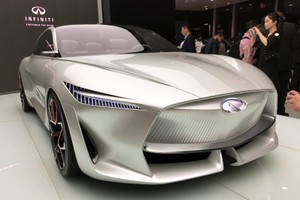Cars in future: Electrified and autonomous, but what will it look like?
When that motor technology is combined with autonomous vehicle advances, the car not only no longer needs the hood but also what the industry calls crash zones.

- Country:
- China
An autonomous driving electric vehicle may not take to the sky any time soon but could one day start to look a bit like The Jetsons’ flying car - a glass bubble without the long hood that is a signature feature of today's gasoline-fueled cars.
The key game-changing technology behind that prospect is the electric motor - a relatively simple and compact propulsion system which allows automakers to eliminate the hood and the ample room underneath needed for a bulky internal combustion engine, an engine cooling apparatus, and complex transmission gears.
When that motor technology is combined with autonomous vehicle advances, the car not only no longer needs the hood but also what the industry calls crash zones.
The upshot: the EV shift might usher in the age of a bubble- or pod-shaped car like those popularised by the 1960s futuristic animated comedy series, The Jetsons.
“That is the next logical step,” Karim Habib, the design chief for Nissan's premium brand Infiniti, told Reuters in an interview.
“It is definitely the next step, particularly if you imagine a world of zero accidents with autonomous drive technology fully working. If cars will never crash, the ultimate most efficient (shape) of a personal mobility could be a glass cube.”
TIMES ARE CHANGING
Going back to the 1920s, automobiles - especially luxury cars - have tended to have long hoods, as the Tesla Model S does now. But that’s about to change.
At the Detroit auto show in January, Infiniti showed a concept car whose styling points towards a not-so-distant future when most cars are going to be electrified.
The Q Inspiration Concept car, which is also going to be shown at the Beijing auto show that opens this week, has a shortened hood, an arcing, coupe-like roofline and SUV-like interior room despite being a sedan.
Daimler AG’s Mercedes-Benz brand has also shown a concept car called the F015 that its wheels set close to the bumpers, and a large interior space under a dramatic roofline that arcs like a rainbow.
Forced in part by stringent fuel economy requirements and other regulations, automakers around the world — especially in China — are scrambling to develop electric battery cars across a wide range of price points.
The technology shift is bringing to the industry change in the way cars are engineered and manufactured. In particular, because of the mechanical and structural simplicity of the EV, which have many fewer components than their gasoline car counterparts, offer greater opportunities for achieving commonality in vehicle platforms and components, as well as manufacturing processes.
Vehicle styling could be equally radical.
(This story has not been edited by Devdiscourse staff and is auto-generated from a syndicated feed.)
- READ MORE ON:
- Electric cars










